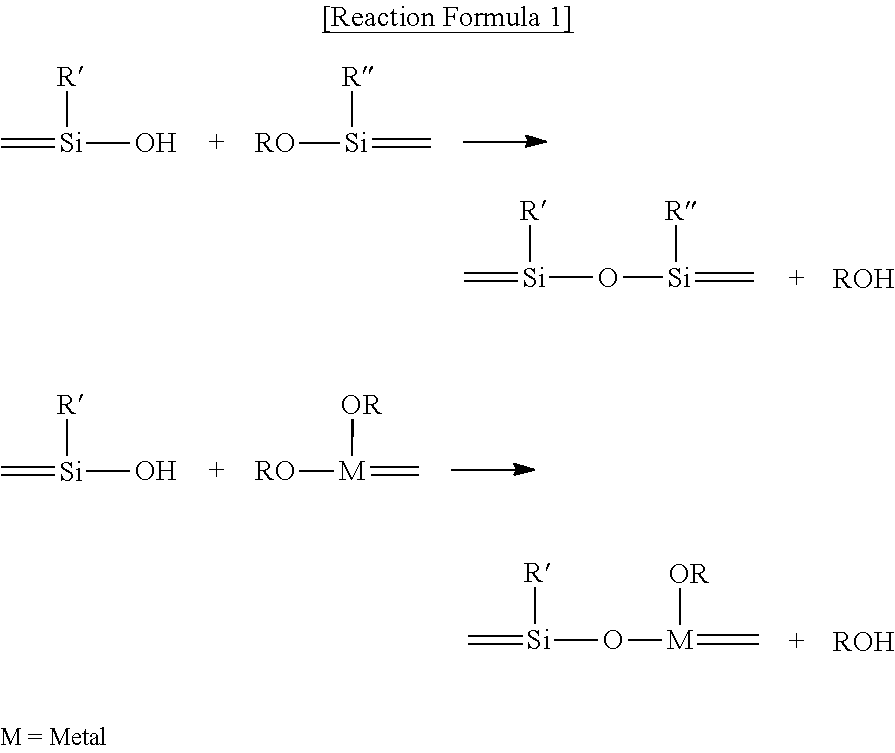Fluorescent Dye-Siloxane Hybrid Resin
a hybrid resin and fluorescence dye technology, applied in the field of fluorescence dyesilane hybrid resins, can solve the problems of deterioration of dispersion stability, high cost, and low thermostability and photostability, and achieve excellent thermostability, photostability and fluorescence characteristics, excellent processibility, and excellent thermostability.
- Summary
- Abstract
- Description
- Claims
- Application Information
AI Technical Summary
Benefits of technology
Problems solved by technology
Method used
Image
Examples
example 1
[0035]7-amino-4-methylcoumarin (coumarin 120) and 3-isocyanatepropyltriethoxysilane were put into a 10 mL glass bottle at a molar ratio of 1:1, the glass bottle was closed by a cover, and then the mixture was reacted for 2 hours at room temperature using a magnetic stirrer. The amino group of 7-amino-4-methylcoumarin was reacted with the isocyanate group of 3-isocyanatepropyltriethoxysilane to obtain an alkoxysilane bonded with coumarin. This alkoxysilane bonded with coumarin was put into a 200 mL flask together with 2-(3,4-epoxycyclohexyl)ethyltrimethoxysilane and diphenylsilanediol at a molar ratio of 0.001:2:3, barium hydroxide, as a catalyst, was added in an amount of 0.1 mol % based on silane, and then the resulting mixture was stirred for 4 hours at 80° C. to obtain a coumarin-siloxane hybrid resin having blue fluorescence. Subsequently, an allylsulfonium hexafluoroantimony salt, as a photocuring catalyst, was added to the obtained coumarin-siloxane hybrid resin in an amount o...
example 2
[0036]2-(6-amino-3-imino-3H-xanthene-9-yl)benzoic acid methyl ester (rhodamine 123) and 3-isocyanatepropyltriethoxysilane were put into a 10 mL glass bottle at a molar ratio of 1:1, the glass bottle was closed by a cover, and then the mixture was reacted for 2 hours at room temperature using a magnetic stirrer. The amino group of 2-(6-amino-3-imino-3H-xanthene-9-yl)benzoic acid methyl ester was reacted with the isocyanate group of 3-isocyanatepropyltriethoxysilane to obtain an alkoxysilane bonded with rhodamine. This alkoxysilane bonded with rhodamine was put into a 200 mL flask together with 3-glycidoxypropyltrimethoxysilane and diphenylsilanediol at a molar ratio of 0.001:2:3, barium hydroxide, as a catalyst, was added in an amount of 0.1 mol % based on silane, and then the resulting mixture was stirred for 4 hours at 80° C. to obtain a rhodamine-siloxane hybrid resin having green fluorescence. Subsequently, phthalic anhydride, as a thermocuring catalyst, was added to the obtained...
example 3
[0037]Fluorescein and 3-isocyanatepropyltriethoxysilane were put into a 10 mL glass bottle at a molar ratio of 1:2, the glass bottle was closed by a cover, and then the mixture was reacted for 2 hours at 70° C. using a magnetic stirrer. The hydroxy group of fluorescein was reacted with the isocyanate group of 3-isocyanatepropyltriethoxysilane to obtain an alkoxysilane bonded with fluorescein. This alkoxysilane bonded with fluorescein was put into a 200 mL flask together with 3-methacrylpropyltrimethoxysilane and diphenylsilanediol at a molar ratio of 0.001:2:3, barium hydroxide, as a catalyst, was added in an amount of 0.1 mol % based on silane, and then the resulting mixture was stirred for 4 hours at 80° C. to obtain a fluorescein-siloxane hybrid resin having green fluorescence. Subsequently, 1,6-hexanedioldiacrylate was added to the obtained fluorescein-siloxane hybrid resin in an equivalent ratio, 2,2-dimethoxy-2-phenylacetophenone, as a photocuring catalyst, was added to the fl...
PUM
| Property | Measurement | Unit |
|---|---|---|
| Viscosity | aaaaa | aaaaa |
| Fluorescence | aaaaa | aaaaa |
Abstract
Description
Claims
Application Information
 Login to View More
Login to View More - R&D
- Intellectual Property
- Life Sciences
- Materials
- Tech Scout
- Unparalleled Data Quality
- Higher Quality Content
- 60% Fewer Hallucinations
Browse by: Latest US Patents, China's latest patents, Technical Efficacy Thesaurus, Application Domain, Technology Topic, Popular Technical Reports.
© 2025 PatSnap. All rights reserved.Legal|Privacy policy|Modern Slavery Act Transparency Statement|Sitemap|About US| Contact US: help@patsnap.com



